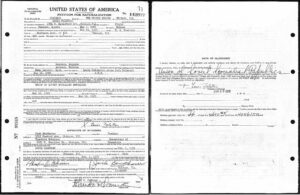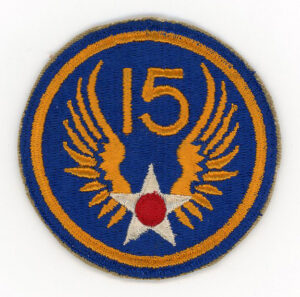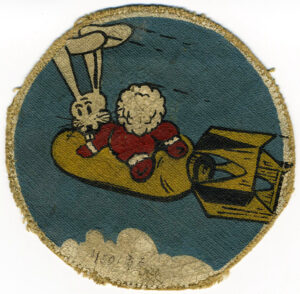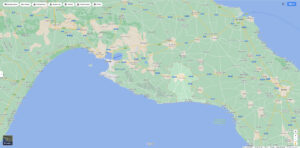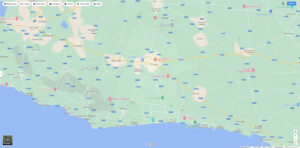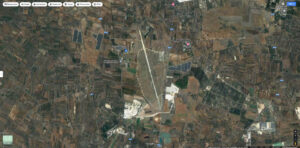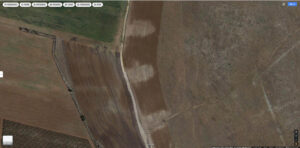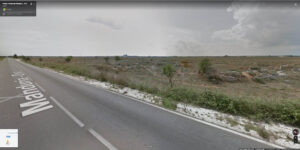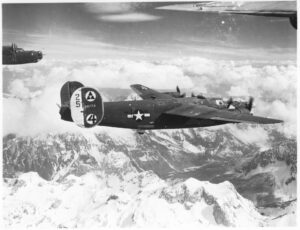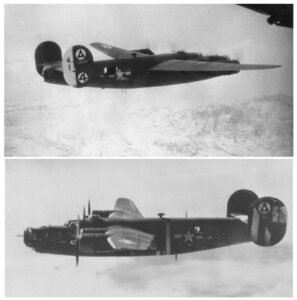It’s appropriate to begin at a beginning.
With that, this post – presenting biographical information about Louis Falstein – is a composite of information derived from his biographical profile as published in a late-1980s edition of Contemporary Authors, excerpts from Alan M. Wald’s Trinity of Passion: The Literary Left and the Antifascist Crusade, documents at Ancestry.com, and, details provided to me by Louis Falstein himself some years back.
We all start somewhere. In Lou Falstein’s case, like his Face of a Hero protagonist Ben Isaacs, he hailed from Eastern Europe, having been born in the city of Nemirov, in the Vinnytsia Oblast, Ukraine, on the 1st of May, 1909. (This city is also the birthplace of Nathan of Breslov, the chief disciple of Rebbe Nachman of Breslov; see also….)
In this Oogle map, Nemirov, denoted by the blue oval, appears in the left center, just southeast of Vinnytsia…
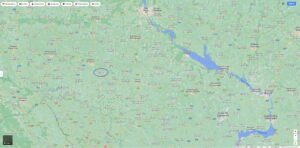 …while the city is in the lower center of this larger scale map.
…while the city is in the lower center of this larger scale map.
While some aspects – unpleasant aspects – of Ben Isaacs life in the Ukraine are related in the latter part of Face of a Hero, the details of Louis Falstein’s own life in the Ukraine are unknown, except for Alan Wald’s comment in Trinity of Passion: The Literary Left and the Antifascist Crusade. Namely: “His father had orchards in the Ukraine, but he became a businessman in the United States.” The 1930 Census lists his parents as Joe (Yoseph bar Avraham Mordechai; 1881-2/5/55) and Bessie (Bessie bat Shmuel; 1887-7/11/57), and his siblings as Frieda, Lorna, Morris, and Tonia (?), all having been born in Russia, and living at 148 Maplewood Street in Chicago. Joe’s vocation is listed as factory laborer, and Louis’ – at the time, he was twenty years old – as clothing cutter.
As revealed by his “Declaration Of Intention” (shown below; via Ancestry.com), Louis departed Europe from Antwerp, Belgium, and arrived in Quebec in mid-1925. From there, he reached his point of lawful entry into the United States – Detroit, Michigan – via the “SCP RR” (South Carolina Pacific Railroad), on May 16, 1925.
He signed his “Declaration Of Intention” on May 29, 1933, and his “Petition for Naturalization” on March 5, 1936. On June 10 of that year, at just over the age of 27, he became an American citizen. At the time, he listed his vocation as “singer”.
Here’s an enlargement of Lou’s portrait in his “Declaration Of Intention”…
…and here’s his Petition for Naturalization:
Leading up the the Second World War, the intervening years of Lou Falstein’s life are recounted Trinity of Passion:
“The family had no interest in either radical politics or Zionism, and Falstein lacked direction as an adolescent. He was forced to go to Hebrew school but found it dull. He attended but did not graduate from high school in Chicago, although he later secured a diploma by taking a special course. During the early Depression he found work for a while as a shoe salesman, but he was mainly unemployed. In 1934 he came to Detroit to seek work in the auto plants. At this time he was drawn to the John Reed Club, where he became friends with the African American poet Robert Hayden and developed an admiration for the radical attorney Maurice Sugar. Occasionally he wrote skits for fund-raising events. His name appeared (as Lewis Fall) as one of the editors of the Detroit Left publication New Voices, but he published nothing. After changing his name for a while to Fallon, because of the Ford Motor Company’s reputation as being anti-Semitic, he at last found work. But when a union leaflet was discovered in his lunch bucket, he was fired and was forced to apply for “pick and shovel” work with the WPA. To his good fortune, he secured a job with the Federal Writers Project.”
At the WPA Falstein found himself under attack by the Black Legion, a neofascist organization that denounced him and other radicals as Red spies and threatened their lives. Falstein recalled that he was referred to in the newspapers as an “agent of the Third International.” Shortly afterward a coworker on the Federal Writers Project was murdered. In order to help save the WPA from elimination, Falstein joined the Save Our Jobs March in Washington, D.C., spending a week living in a tent in Potomac Park and lobbying congressmen. At this time, Falstein became obsessed with the Spanish Civil War. He generally felt like an unheroic, perhaps even cowardly person, but the logic of his political views made him susceptible to pressure to take action on behalf of the Spanish Republic.
When two of his friends joined the Abraham Lincoln Brigade and were killed in battle, Falstein volunteered. Before he could depart, however, he received a court order to appear as a witness at the impending trial of the members of the Black Legion. This was an event that attracted worldwide attention. Legion “executioners” paraded before a crowded courtroom and bragged about their exploits in killing scores of persons – sometimes by burying them alive in lime pits – because they were African American or “Red unionists.” When the trial was over, Falstein found work at a General Motors plant, only a week before the famous sit-down strike began. He remained in his plant for six weeks. He was often frightened by the efforts of the police and vigilantes to evict the strikers, but he drew strength from his sense of solidarity with other men and women in the battle.
Just before the start of World War II he moved to New York. As a Communist he believed that he should participate in the war, even though he felt fearful and unsuited. To his amazement he was accepted for combat duty in the army air force…”
Here’s Louis’ Draft Registration Card, which was completed on October 16, 1940. As can be seen, Louis was by now employed at the A.F.G. literary agency at 545 5th Avenue in Manhattan, otherwise known as the Lorraine Building. Though this occupation presaged the future direction of his life, of A.F.G. I know nothing further, for there are no records – none! – about the agency at either Duck Duck Go or Oogle.
Now, we jump a few years ahead.
As related by Ben Isaacs’ in Face of a Hero, his bomb group was known as the “Tigertails”, his bomb squadron the “227th”, their base “Mandia” at Italy. These clues ostensibly suggest that Louis Falstein served in the 722nd Bomb Squadron of the 450th Bomb Group, for the Group’s identifying marking late in the war was a series of vertical black and yellow stripes painted on the fins and rudders of their planes, while their base was at Manduria. The Group’s original form of aircraft identification was the white-painted rudders of their Liberators, thus their initial (continuing and much better known!) nickname being the “Cottontails”.
Louis confirmed my suppositions some years back, verifying that while he indeed served in the 450th Bomb Group, he actually was a member of the 723rd – not the 722nd – Bomb Squadron.
Unfortunately, details of Lou’s actual military service are unknown.
A review of the historical records of the 450th Bombardment Group and 723rd Bomb Squadron obtained from the Air Force Historical Research Agency – at least, those records that I have access to or know of (!) – does not reveal Lou’s name, but as the expression goes, “absence of evidence is not evidence of absence”. However, his name does appear in the context of a most interesting document at the website of the 450th Bomb Group Memorial Association. So, other than the all-too-succinct biographical blurb published in the jacket and on the cover of the 1950 and 1999 editions of Face of a Hero, nothing is known about his crew, the dates and destinations of his combat missions, or significant experiences during his combat tour. Similarly, like very many American Jewish servicemen who served in combat in WW II and received military awards (or were casualties) his name never appeared in the 1947 compilation American Jews in World War II.
Still, there are a few pictures to go by.
The photo below will be familiar to readers of Steerforth Press’s 1999 edition of Face of a Hero, for this image – overprinted, of course, with title, author’s name, and the blurb, “The novel of World War II air combat that predated Catch-22 by a decade” – comprises the book’s cover art.
The backdrop of the portrait, taken in November of 1944, is the rear fuselage of a B-24 Liberator. It can be seen that the star cocarde has an unusually dark surround, which is probably a dark blue overpaint of the red surround which was used as part of the Army Air Force national insignia until August of 1943. The light-colored camouflage paint may be a color known as “desert pink”, or, it’s very (very!) deeply faded olive drab. As will be related in a future post, Ben Isaacs’ (and Lou Falstein’s?) last combat mission seems to have taken place in late January to early February of 1945, which implies that this November, 1944 photo – a publicity shot? – a picture for his family? – was taken in the midst of his combat tour.
Since Lou is wearing a tie, the picture is kind of formal. He would have been 35 years old at the time, an unusually “old” age (but then again by no means unheard of) for an Army Air Force bomber crewman in 1944.
This insignia is well-known: It’s the emblem of the 15th Air Force.
This insignia, a cottontail bunny rabbit riding a bomb through the sky, is a little less well-known: It’s the insignia of the 723rd Bomb Squadron. To be specific, this is the patch which once adorned Louis Falstein’s own Army Air Force jacket.
______________________________
This series of Oogle maps and air photos shows the location and present appearance of the 450th Bomb Group’s base at Manduria, Italy.
First, this map shows the location of Manduria relative to the coast of Italy. The city is located along the southern edge – or inner “heel” – of the Italian “boot”, southeast of Taranto and inland from the coast of the Ionian Sea.
Moving in closer, this view reveals that the southern limits of Manduria lie six miles north of the coast. However, the Oogle map doesn’t reveal the location of the Cottontails’ base – between highways SP96 and SP97, just north of the city limits – probably because the air base has not been used as such for decades.
Moving to a slightly larger scale brings the 450th Bomb Group’s former base into view in obvious and striking clarity. The base is situated about two miles from the built-up northern outskirts of Manduria, and is surrounded by farmland and orchards (?), with quarries at the south. Given that nearly eight decades have transpired since WW II’s end, the fact that the airfield has not been converted back to agricultural or commercial (at least, as of the date this image was taken) is surprising.
This close view clearly shows the Cottontail’s single runway, which is oriented SSE-NNW. The locations of thirteen hardstands can be seen along west perimeter road, and three less clearly along on the east road. The network of the base’s interior roads is also visible.
Here are three hardstands along the west perimeter track, each measuring about 50 by 100 feet. It appears that the land just adjacent to this group of hardstands, along the inner edge of the perimeter track, is used for agricultural purposes. Remnants of two roads inside the perimeter road are also visible.
Since no active highways or roads traverse the site of the airfield within the outer track, Oogle street views of the base can only be accessed via the active highway – SP97; Strada Provinciale Manduria-Oria – paralleling the eastern side of the former airfield. Highway SP96 is too far west to obtain any views of the former base.
This Oogle street view looks into and across the base towards the southwest from northeastern “corner” of the field, from a point where SP97 intersects the east-west access road running across the base. At this point – at the entrance to the base at the northeast “corner” of the airfield, as it were – there appears to be some kind of marker or monument in the form of two pillars and a wall, with a plaque between them. Note that the stone buildings inside the base, in the left center of the photos – Masseria Schiavone ex campo aviazione – are abandoned and dilapidated.
For the image below, we’ve virtually traveled south (from the above photo) along SP97 to a point about a fourth of the way between the base’s northeast corner, and, its southern point. We are again looking southwest “into” the airfield, from a point on SP97 opposite the Centrale Electrica Solare bank of solar collectors.
What’s especially interesting is the sign along the former airfield’s boundary, on which is painted: ZONA-MILITARE – DIVIETO DI ACCESSO, meaning “Military Zone – No Access”. In 2022, why? Is there live ordnance buried at the airfield? I don’t know. Even assuming that the base was stripped of all salvageable material after it was abandoned in 1945, one wonders what buried artifacts might today be found with a metal detector.
______________________________
This photo below, which I received from Louis, is interesting.
Shown are two 450th Bomb Group B-24 Liberators in formation over snow-covered mountains (the Alps?), the nearer aircraft (41-28774) being a B-24H. The triangle-in-circle at the top of the fin designates the 15th Air Force’s 47th Bomb Wing, which – in addition to the 450th Bomb Group – was comprised of the 98th, 376th, and 449th Bomb Groups. The “4” at the bottom of the fin, in combination with the white rudder (the above-mentioned “Cottontail” marking) together designate this plane as being assigned to the 450th Bomb Group. The number “25” on the rudder indicates that 41-28774 is an aircraft of the 450th Bomb Group’s 721st Bomb Squadron, which, along with the 720th, above-mentioned 722nd, and 723rd squadrons, were the four squadrons comprising the 450th.
If you examine the image closely, you’ll notice a spherical object suspended below 41-28774’s fuselage. This isn’t a Sperry ball turret; it’s a radome housing H2X radar, used for ground mapping for bombing missions during inclement weather. The radome has a light-colored horizontal band painted around it, I think a visual cue for adjacent planes as to whether the radome has actually been fully, or only partially, extended. Another image of this plane, taken a moment later in flight, can be viewed at the American Air Museum in Britain.
41-28774 survived the war, to be returned to the United States and salvaged in August of 1945. I suppose it’s been long since turned into aluminum siding.
This pair of photos, from the 450th Bomb Group Memorial Association, showing Down & Go (42-52152), a B-24H of the 722nd Bomb Squadron, are an excellent example of the early and late group identification markings painted on 450th Bomb Group B-24s. Just like the above image of B-24H 41-28774, the upper picture shows the outer rudders in white, with an individual aircraft number – in this case, 41 in black – painted upon them. The lower picture shows how the white rudder insignia has been replaced by a set of vertical black and white stripes, but the fin retains the “triangle in circle” 47th Bomb Wing marking at the top of the rudder.
Same plane, different clothes.
Down & Go was written off after a taxiing accident on September 8, 1944.
____________________
Digressing, another part of Louis Falstein’s life, though not a part of the world of Face of a Hero, was the wartime experience of his cousin, Lawrence I. Falstein. A fellow Chicagoan (from 1004 North Kedzie Avenue), Lawrence, the son of Fannie H. Falstein, was born on July 25, 1925. A PFC (36694283) in K Company, 110th Infantry Regiment, 28th Infantry Division, Lawrence was captured during the Ardennes Offensive on December 20, 1944, and was a POW at Stalag 4B, in Muhlberg, Germany. Akin to Louis, his name never appeared in American Jews in World War II.
____________________
While Louis Falstein’s literary oeuvre will be presented and discussed in subsequent posts, the only substantive information I’ve found about his postwar personal life again comes from Trinity of Passion: The Literary Left and the Antifascist Crusade, which states, “Politically, he remained outside the Party membership but was more loyal to the Party than ever. He faithfully read the Daily Worker and the New Masses and its successors. Through the dancer and poet Edith Siegal he met Michael Gold, and he knew Len Zinberg as well. He believed that Stalin could do no wrong and was unaffected by the revelations at the Twentieth Congress in 1956, and he continued to read and study Marx in his spare time. His wife worked as a guidance counselor, and in 1946-48 he took courses at New York University, after which he taught writing there in 1949-50 and at City College in 1956.”
As for Mike Gold (not the most congenial fellow) and Len Zinberg, the following snippets from Wikipedia are enlightening:
“Mike Gold was the pen-name of Jewish American writer Itzok Isaac Granich. A lifelong communist, Gold was a novelist and literary critic. His semi-autobiographical novel Jews Without Money (1930) was a bestseller. … As a critic, Gold fiercely denounced left-wing authors who he believed had deviated from the Communist Party line. Among those Gold denounced were screenwriter Albert Maltz and “renegade” Ernest Hemingway, who while never a Communist had been sympathetic to leftist causes but came under fire by some for his writing on the Spanish Civil War in For Whom the Bell Tolls. Hemingway responded with “Go tell Mike Gold, Ernest Hemingway says he should go fuck himself.”
“Leonard S. Zinberg, otherwise known as Ed Lacy, was a member of the League of American Writers, and served on its Keep America Out of War Committee in January 1940 during the period of the Hitler-Stalin pact.”
Much more than at Wikipedia, Zinberg / Lacy’s life is covered in great detail by Ed Lynskey, at MysteryFile. Regardless of his politics, Lacy … Zinberg … was a very interesting man.
I was more than stunned to read about Louis’ longstanding identification with Marxism, but on reflection, in light of his family history, social background, vocational history, the social circles in which he moved, and especially the tenor of the times, his ideological loyalty to and identification with “the Party” – even if he was thankfully never a member – would not (alas; alas) have been altogether unprecedented. Still, for one’s beliefs to have remained unchanged by Nikita Kruschev’s revelations at the closed session of the Twentieth Party Congress on February 25, 1956, and, the Soviet Union’s repression of the Hungarian Uprising in 1956 (both events having been the impetus for many to break all affiliation with Communism, whether in terms of beliefs or politics) says much about the nature of the human capacity to believe, and, the difficulty of change.
If anything mitigates all this, it is that regardless of the nature of Louis Falstein’s political beliefs, they neither motivated nor were evident in Face of a Hero or his other works. This is especially so in terms of the centrality of his identity as a Jew, and, the ongoing survival and future of the Jewish people, which will remain anathema to Marxism and really all forms of secular collectivism.
____________________
Lou Falstein after the war, from Trinity of Passion.
Louis Falstein passed away on May 22, 1995. I don’t know the location of his place of burial, though I assume it’ near New York City.
Some Things to Refer to…
Books
Bell, Dana, Air Force Colors Vol. 2 – ETO & MTO 1942-45, Squadron / Signal Publications, Carrollton, Tx., 1980
Besancon, Alain, A Century of Horrors – Communism, Nazism, and the Uniqueness of the Shoah, ISI Books, Wilmington, De., 2007 (“Is it better to be a beast that plays the angel or a man that plays the beast – given that both are beasts “of prey”? This is indeterminable. In the first case, the degree of the lie is stronger and the appeal is greater. The communist falsification of the good went deeper, since the crime more clearly resembled the good than the naked crime of the Nazi. This trait allowed communism to expand more widely and to work on hearts that would have tuned away from an SS calling. Making good men bad is perhaps more demonic than making men who are already bad worse.“)
Blue, Allan G., The B-24 Liberator – A Pictorial History, Charles Scribner’s Sons, New York, N.Y., 1975
Dublin, Louis I., and Kohs, Samuel C., American Jews in World War II – The Story of 550,000 Fighters for Freedom, The Dial Press, New York, N.Y., 1947
Eldad, Israel (Lehi.org; see also Jewish Virtual Library) Jewish Revolution – Jewish Statehood, Shengold Publishers Inc., New York, N.Y., 1971 (Writing in 1971 and speaking of the late 19th and early 20th centuries, “The present flirtation [late 1960s early 1970s] of many Jewish youngsters with the New Left cannot hold a candle to the spell that the socialist-communist ideal cast over the young Jewish generations at that time. It is no exaggeration to say that the best Jewish minds, the nation’s greatest mental and physical resources, were sacrificed on the altar of this new God.”)
Falstein, Louis, Face of a Hero, Steerforth Press, South Royalton, Vt., 1999
Freeman, Roger, Camouflage & Markings – United States Army Air Force 1937-1945, Ducmins Books Limited, London, England, 1974
Rottman, Gordon and Chin, Francis, US Army Air Force I, Osprey Publishing Ltd., London, England, 1993
Rust, Kenn C., Fifteenth Air Force Story, Historical Aviation Album, Temple City, Ca., 1976
Wald, Alan M., Trinity of Passion: The Literary Left and the Antifascist Crusade, University of North Carolina Press, Chapel Hill, N.C., 2014
Nemirov, at…
…Yivo
…International Jewish Cemetery Project
…Uncovering My Family History, the untold story of Chassidism and the Holocaust (by Shmuel Polin)
The Revelations and Events of 1956
Khrushchev’s Secret Speech, 1956, at NARA
Premier Nikita S. Khrushchev – The Secret Speech to the Communist Party’s Central Committee – Stalin and the Cult of Personality – Moscow, February 25, 1956 (PDF full text), at Inside the Cold War
Hungarian Revolution of 1956 (June 23 to November 11, 1956), at Wikipedia
Air Force Historical Research Agency Unit Histories
723rd Bomb Squadron
A0656 Sq-Bomb-718-Hi 9/47 through Sq-Bomb-735-Hi 6/44
450th Bomb Group
B0593 Gp-449-Su-Op-S 24 Apr 45 through Gp-450-Hi 8/44
B0594 Gp-450-Hi 9/44 through Gp-450-Su-Op-S 1-5/44
B0595 Gp-450-Su-Op-S 6-10/44 through Gp-451-Hi 1/45




